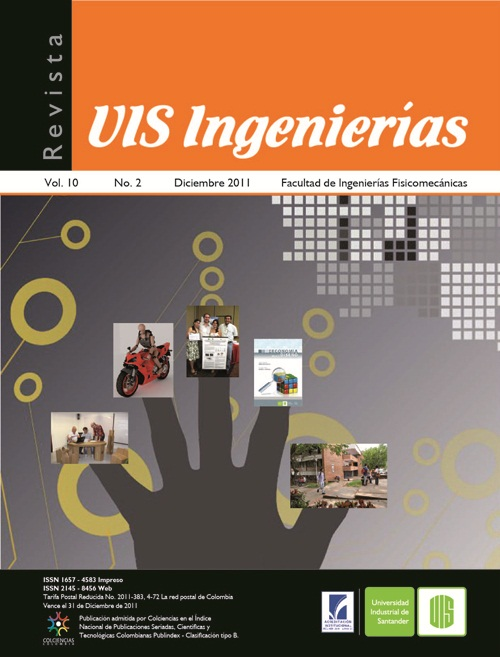Relation between the transfer lot size and the performance of a "Flow-Shop" type manufacturing system
Published 2011-12-15
Keywords
- Machine scheduling,
- flow shop,
- process batch,
- transfer batch,
- mixed integer programming
How to Cite
Abstract
This research uses batch sizing as a strategy that complements machine scheduling in the companies. The objective is analyze the flow shop production system behavior when it uses different batch transfer size, under the performance measures makespan and mean flow time. The experimental design includes the transfer batch size policy, the demand level and the mix products. It results in 192 different analysis situations; these were represented under a mixed integer programming formulation and then were solved in GAMS, using CPLEX as optimizer. Results indicate that use transfer batch improve the production system performance. However, by the setup influence, select the transfer batch size more appropriate depends of the amount of products made.
Downloads
References
- R. Jacobs and D. Bragg, “Repetitive Lots: flowtime reductions through sequencing and dynamic batch sizing,” Decision Sciences, vol. 19, 1988, pp. 281-294.
- U.Karmarkar, “Lot-sizing and sequencing delays,” Management Science, vol. 33, 1987, pp. 419-423.
- C. N. Potts, and K. R. Baker, “Flow shop scheduling with lot streaming,” Operations Research Letters, vol. 8, 1989, pp. 297-303.
- D. Kropp and T.Smunt, “Optimal and heuristic models for lot splitting in a flow shop,” Decision Sciences, vol. 24, No. 4, 1990, pp. 691-708.
- K. Baker and D. Pyke, “Solution procedures for the lot streaming problem,” Decision Sciences, vol. 21, No. 3, 1990, pp. 475-489.
- R. Vickson and B. E. Alfredsson, “Two and threemachine flow shop scheduling problems with equal sized transfer batches,” International Journal of Production Research, vol. 30, 1992, pp. 1551-1574.
- S. Benjaafar, “On production batches, transfer batches and lead times,” IIE Transactions, vol 28, No. 5, 1996, pp. 357-362.
- T. Smunt, A. Buss and D. Kropp, “Lot splitting in stochastic flow shop and job shop environments,” Decision Sciences, vol. 27, No. 2, 1996, pp. 215- 238.
- S. Duzère-Pérès and J. Laserre, “Lot streaming in job-shop scheduling,” Operations Research, vol. 45, No. 4, 1997, pp. 584-595.
- A. Drexl and A. Kimms, “Lot sizing and scheduling: survey and extensions,” European Journal of Operational Research, vol. 99, 1997, pp. 221-235.
- R. Ruben and F. Mahmoodi, “Lot splitting in unbalanced production systems,” Decision Sciences, vol. 29; No. 4, 1998, pp. 921-949.
- A. Langevin and D. Riopel, “Transfer batch sizing in flexible manufacturing systems,” Journal of Manufacturing Systems, vol. 18, No.2, 1999, pp. 140-151.
- A. Kalir and S. Sarin, “Evaluation of the potential benefits of lot streaming in flow-shop systems,” International Journal of Production Economics, vol. 66, 2000, pp. 131-142.
- H.Stadtler, “Multilevel lot sizing with setups times and multiple constrained resources: Internally Rolling Schedules with lot-sizing windows,” Operations Research, vol. 51, No. 3, 2003, pp. 487-502.
- C. Suerie and H. Stadtler, “The capacited lot-sizing problem with linked lot sizes,” Management Science, vol. 49, No. 8, 2003, pp. 1039-1054.
- D. QuadtandH. Kuhn, “Conceptual framework for lot-sizing and scheduling of flexible flow lines,” International Journal of Production Research, vol. 43, No. 11, pp. 2291-2308.
- K. Caballero. Evaluación del impacto del tamaño del lote de transferencia en la programación de operaciones de un sistema productivo del tipo flowshop [Trabajo de Grado pregrado]. Universidad Industrial de Santander, Bucaramanga, 2006.
- D. Biskup and M. Feldmann, “Lot streaming with variable sublots: an integer programming formulation,” Journal of Operational Research, vol. 57, 2006, pp. 296-303.
- S. Marimuthu, S. Ponnambalam and N. Jawahar, “Tabu search and simulated annealing algorithms for scheduling in flow shops with lot streaming” ProQuestScience Journals, Institution of Mechanical Engineers, 2007, pp. 317-330.
- E. Goldratt. “Producción: como mejorar con TOC”. Guía del Instructor. Instituto Avraham Y. Goldratt. 1996.
- M. Niño. Evaluación del sistema de programación de operaciones DBR [Tesis doctoral].Universidad Politécnica de Cataluña, Barcelona, 2002.
- GAMS/CPLEX. 2002. GAMS – The Solver Manuals. Washington D.C

